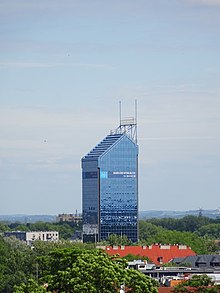Grzegórzki

Grzegórzki is a district of Krakow and a former village southeast of Krakow's old town on the left bank of the Old Vistula in Poland . The place is named for the district II Grzegórzki .
history
The place was first mentioned in 1388 as Grzegorszkowicze or villam Grzegorkowicz . The German surname Gregorsdorf was mentioned four years later, after which it appeared five times in the sources, the last time in 1472 ( Gregerszdorff ). After that, in the years 1489 to 1508, the village was called Wola [Grzegorskowa / Grzegorzoszka / Grzegorzowska / Gregorij]. In 1521 the current name appeared as Grzegorzki . It has been suggested that the name is derived from the knight Grzegorz Spycimir or from Grzegorz from Pisar des Herbs Topór and was founded around the first half of the 14th century.
From the 15th century the city of Krakow took the village with Dąbie on lease, but Krakow often sold the village to rich citizens or councilors. Politically, the village initially belonged to the Kingdom of Poland (from 1569 in the aristocratic republic of Poland-Lithuania ), Krakow Voivodeship , Proszowice District (later Kraków District). During the third partition of Poland , Grzegórzki became part of the Habsburg Empire in 1795 . In the years 1815-1846 the village belonged to the Republic of Krakow , in 1846 it was annexed again as part of the Grand Duchy of Krakow to the countries of the Austrian Empire. From 1855 Grzegórzki belonged to the Kraków District . A fortification of the Krakow Fortress was built by Austrians in 1858. Industrialization began in the late 19th century. a. a factory of Semperit AG was established . In 1871 the Kraków Municipal Slaughterhouse was established in Grzegórzki.
In 1900 the municipality of Grzegórzki with the district of Piaski had an area of 152 hectares, 138 houses with 3,458 inhabitants, the majority of whom were Roman Catholic (3,360) and Polish - speaking (3,286), 64 Jews and 24 Greek Catholics , 43 German-speaking.
The municipality's administration asked the city of Cracow three times for affiliation. On April 1, 1910, the southern part of the municipality was incorporated into Krakow, while in the north only two small parts of Piaski on the Białucha ( Prądnik ) were annexed as Krakow exclaves and the rest of Piaski, which became a gap in the northeast of Krakow, fell to Rakowice , but the Piaski estate was also incorporated into Krakow from 1924 to 1925. The new district also included an area of Kazimierz to the west of the railway line, with the New Jewish Cemetery . In 1921 the district XIX. Grzegórzki 243 buildings with 5141 inhabitants, of which the majority of Polish nationality (5057) and Roman Catholic (4897), also the largest minority of Jews counted 169 people.
Individual evidence
- ↑ a b Tomasz Jurek (editor): GRZEGÓRZKI ( pl ) In: Słownik Historyczno-Geograficzny Ziem Polskich w Średniowieczu. Edycja elektroniczna . PAN . 2010-2016. Retrieved April 22, 2019.
- ↑ Kazimierz Rymut , Barbara Czopek-Kopciuch: Nazwy miejscowe Polski: historia, pochodzenie, zmiany . 3 (EI). Polska Akademia Nauk . Instytut Języka Polskiego, Kraków 1999, p. 419 (Polish, online ).
- ↑ Ludwig Patryn (Ed.): Community encyclopedia of the kingdoms and countries represented in the Reichsrat, edited on the basis of the results of the census of December 31, 1900, XII. Galicia . Vienna 1907 ( online ).
- ↑ Główny Urząd Statystyczny: Skorowidz miejscowości Rzeczypospolitej Polskiej. Województwo krakowskie i Śląsk Cieszyński . Warszawa 1925, p. 17 [PDF: 27] (Polish, Woj.krakowskie i Sląsk Cieszynski miejscowości.pdf ).
Web links
- Grzegórzki . In: Filip Sulimierski, Władysław Walewski (eds.): Słownik geograficzny Królestwa Polskiego i innych krajów słowiańskich . tape 2 : Derenek – Gżack . Sulimierskiego and Walewskiego, Warsaw 1881, p. 890 (Polish, edu.pl ).
- Grzegórzki . In: Filip Sulimierski, Władysław Walewski (eds.): Słownik geograficzny Królestwa Polskiego i innych krajów słowiańskich . tape 15 , part 1: Abablewo – Januszowo . Walewskiego, Warsaw 1900, p. 543 (Polish, edu.pl ).
Coordinates: 50 ° 3 ' N , 19 ° 58' E
